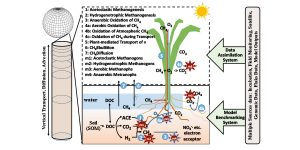
We summarize 39 terrestrial CH4 models to characterize their strengths and weaknesses and to suggest a roadmap for future model improvement and application. Our key findings are that: (1) the focus of CH4 models has shifted from theoretical to site- and regional-level applications over the past four decades, (2) large discrepancies exist among models in terms of representing CH4 processes and their environmental controls, and (3) significant data-model and model-model mismatches are partially attributed to different representations of landscape characterization and inundation dynamics. Three areas for future improvements and applications of terrestrial CH4 models are: (1) CH4 models should more explicitly represent the mechanisms underlying land-atmosphere CH4 exchange, with emphasis on improving and validating individual CH4 processes over depth and horizontal space, (2) models should be developed that are capable of simulating CH4 emissions across highly heterogeneous spatial and temporal scales, particularly hot moments and hot spots, and (3) efforts should be invested to develop model benchmarking frameworks that can easily be used for model improvement, evaluation, and integration with data from molecular to global scales.
Xu, X., Yuan, F., Hanson, P. J., Wullschleger, S. D., Thornton, P. E., Riley, W. J., Song, X., Graham, D. E., Song, C., and Tian, H.: Reviews and syntheses: Four Decades of Modeling Methane Cycling in Terrestrial Ecosystems, Biogeosciences Discuss., doi:10.5194/bg-2016-37, in review, 2016.

